2nd International Conference on Croatian Diaspora Tourism in Split Announced
March 18, 2019 - Tourism and business links between Croatia and its diaspora are improving, with the latest diaspora conference set to take place in Split in May.
A nice thing is happening with the complicated relationship between Croatia and its diaspora - the younger, business-minded generation from the diaspora and the Homeland are busy exploring ways they can cooperate, strengthen their bonds and move Croatia forward.
Those bonds are getting stronger, as Croatia's entrepreneurial class are forging links with like-minded diaspora businessmen and entrepreneurs.
There have been a series of great diaspora conferences in recent times, some of which it has been a pleasure to be a foreign fly on the wall (if you have ever wondered what a diaspora conference looks like through foreign eyes, it is something like this), and the latest is going to take place in on May 17-18 in Split, the 2nd 2nd International Conference on Croatian Diaspora Tourism.
"With the new trend in tourism appearing, Diaspora tourism, along with reports from sources such as the UN World Tourism Organisation predicting continued growth in world tourism, focus is turning towards how communities can cater for the tourism needs of their Diaspora cohort. Diaspora tourism includes experiences which focus on the study of culture, art, folklore, sports games and pilgrimages, to name a few. Immigrants and descendants of immigrants from countries that maintain close relations with their Diaspora, such as Israel, Mexico, China, Ireland, Portugal, the Philippines, Polish, Czech, Italy and Croatia along with others, are taking on a multitude of roles in the Diaspora tourism market. They not only have the role of consumer in this market but they are also the investors and creators of opportunities. The Diaspora tourism, international conference aims to bring together scientists and tourism experts from different countries of the world, especially the Mediterranean, in order to share their experiences from their countries and collaborate in developing new understandings and approaches around Diaspora tourism."
Proposed Themes
Experiences of diaspora tourism, a general overview
Investment Foundation in tourism (investment, the possibility of buying real estate…)
Promotion of Diaspora tourism by emigrants in the countries where they live
Cultural tourism (the museum, archives, etc., music, folklore, theater and other festivals and events)
Sports tourism (young people, recreation, etc.)
Art and Tourism (and the possibility of linking exposure to emigrant artists)
Health tourism and the ageing population
For more information on the conference and to reserve your place, visit the official website.
For an overview of the Croatian diaspora, check out the new Total Croatia information site and its introduction to the Croatian diaspora.
Split United: Master Plan for Kopilica and East Coast Presented
A master plan study was presented in Split on Monday which will revitalize the city’s East Coast and Kopilica area. The master plan was submitted by consultants from the company IC Consulenten from Austria. Split is one of many European cities that have resorted to long-term urban planning, supported by the European Bank for Reconstruction and Development, which co-financed the project with 600,000 euro, reports Dalmacija Danas on March 18, 2019.
Victoria Zinchuk, director of EBRD in Croatia, said she was lucky to be in Split today and explained why the EBRD decided to support this project. Zinchuk said that Split has great potential and that ERBD wants this to be only one in a series of projects that they will co-finance. She stressed that this would give a boost to the development of Split and thanked everyone who worked on this project, which required a lot of effort.
Zinchuk added that they did not see the project as solving traffic congestion but rather creating a chance for the local population to gain new jobs.
James Mathews, a representative of the Austrian company IC Consulenten, said that Split has a lot to offer, and the goal of the project is to permanently increase housing and halt traffic congestion in the city center. He added that Kopilica would thus see a new railway and bus station, and the eastern coast of the city harbor and the airport would be connected by light rail.
From the very beginning, the Ministry of Sea, Transport and Infrastructure has been involved in the project.
“I am glad that there is interest in this study, which is an initiative for the development of spatial plans and, in the end, launching and realizing large projects in Split. The Ministry participated in the master plan. Without the distribution of traffic in this area it is impossible to accomplish this project. The traffic is most directly related to Kopilica and the East Coast. The Ministry prepared a whole series of transport projects that will ultimately contribute to the realization of all this.
The project of the fast road from Trogir to Omiš is ongoing. It is necessary to make a link from Solin to Podstrana and bypass Omiš. The agglomeration of about 300,000 inhabitants will be connected to one whole, and this is, after the Pelješac Bridge, the largest Croatian road construction project.
Apart from that, a whole range of projects are being developed, which we will talk about on Tuesday. Finally, the airport will be connected to Split by rail. In the 1990s, the EBRD participated in the preparation and beginning of realizing the EKO project, which is probably the most significant project implemented in Croatia. Over 300 million euro has been withdrawn, and it is my pleasure to see the gentlemen from the ERBD. I want this master plan to be the initiative of the future development of Split and the driver of all spatial plans that will lead to the realization of all the content that should be made in these two locations,” said State Secretary Tomislav Mihotić.
The mayor of Split, Andro Krstulović Opara, did not hide his satisfaction.
“Our generation, your generation does not have the luxury to miss this. That is why this public hearing, which will last five to six weeks, with all of the workshops, is an excellent opportunity to perform tasks among different generations. I was critical of some of my predecessors, but I do not think I'm smarter than them. We have just taken advantage of the exceptional circumstances that have given us membership in the European Union and we are using the benefits of this unity.
The EBRD provided us with this great opportunity we decided to use. This plan is concentrated on several goals. The main goal is to achieve a city of the future that is concentrated on the future of young families and job creation, but also the changing structure of our city. We are talking about traffic, creating a new space for business and taking advantage of opportunities using examples from Vienna and London, who have achieved excellent results for their citizens with their knowledge.
Split is positioned as the center of the eastern Adriatic Coast and deserves what was here at the beginning of my address, and this is a common approach to thinking about the future that will have the same amount of time for the next few decades. Openness is something we want to see. Our cooperation and responsibility towards the generation in front of us is expected to be the best.
We want a Mediterranean city of the future, we want to create a whole host of benefits for young families to concentrate on raising their families here. We are planning on more than 20,000 jobs in this project. This is a generational step we can, want and and will use,” the mayor said.
I am convinced that by presenting this plan, by the quality of our experts, and by the public, which is invited to participate, we will not miss this, but we will take the opportunity. It's time - right now! I can see on your face that you are waiting to accomplish this goal, which we have presented in a contemporary way. United Split - Split united,” mayor Krstulović Opara finished his address.
The master plan, among other things, defines new tourism and residential properties. On the East Coast, the construction of residential buildings, hotels, and garages on several levels are planned. The East Coast would be "a place to preserve and enhance the historical significance of UNESCO heritage and a new place of residence for the local population."
In Kopilica, a new cargo port (RoRO) is planned for automobile transportation to the islands, but also a new waterfront or promenade and a tunnel below Bačvice. As a measure to retain inhabitants in the city, they plan to build 8,984 apartments in Kopilica and 286 apartments on the East Coast. The aim is to bring 19,764 inhabitants to Kopilica and 629 to the East Coast.
The bridge across the Kaštela bay was considered a "long-term national project" that ensures access to the port in Kopilica from the state road. There would also be residential buildings, shops, rest areas, parks, and catering facilities along the coast.
Unlike the past development vision, where this area was viewed only as a transit hub, it will now become a “modern neighborhood that has housing, education, a business center, and public, entertainment and tourist facilities."
You can see a photo gallery for the plans at Kopilica and the East Coast at Splitski Dnevnik. More details to come.
To read more about lifestyle in Croatia, follow TCN’s dedicated page.
HNL Round 25 Recap: Hajduk Jumps to Fifth, Rijeka Tops Osijek
March 18, 2019 - The 25th round of the Croatian First League was held from March 15 to 17, 2019, and saw Hajduk inch even closer to the top three, Rijeka topple Osijek, and Dinamo claim another win.
Group of Young Croats Create e-Vision Project for the Blind
For such a small country, the Republic of Croatia boasts a wealth of talent across all fields, from medicine to sport and from science to innovation and invention, Croats have given a huge amount to the rest of the world.
While Zadar's Luka Modrić might be the household name of Croatian sport, and the likes of Nikola Tesla and Mate Rimac might be the Croats best known to the world when it comes to science, technology and innovation, there are many more individuals in Croatia given less exposure who have a lot to offer the world, and on across an extremely varied platform consisting of all fields.
As SibenikIN writes on the 16th of March, 2019, a young woman from the historic Dalmatian city of Šibenik, Anastazija Verović, a student of FESB, along with her colleagues, has designed an innovative new device for helping the blind. Thanks to her creation, Anastazija and her team have received yet another award from Split-Dalmatia County for this project,.
Anastazija Verović, Lucija Visković, Ena Sarajlić and Ana Žunabović, are all Croats in their fifth year of graduates studies in computer science at FESB and they expressed their desire to help both the blind and other partially sighted people.
Their desire led this talented young group of Croats to create the e-Vision project, an intelligent device which functions as a bracelet and allows blind and visually impaired persons to move around in spaces. For this praiseworthy project, they have rightfully received a second award in the amount of 4,000 kuna from Split-Dalmatia County.
Split-Dalmatia County Prefect Blaženko Boban presented the presented the award to the talented group of FESB students as the brains behind the best student entrepreneurial and innovative project, according to a report from Dalmacija News.
The first prize of 5,000 kuna was awarded to the e-Agrar project, and was handed over to another talented group of Croats - Slaven Damjanovic, Martin Pervan, Dražen Pervan and Marko Calić. Otherwise, the obviously highly talented Anastazija is set to graduate computer science at FESB this coming summer.
Make sure to stay up to date on Croatian-made innovation, ideas and technology by following our dedicated Made in Croatia page.
Honorary Consulate of Spain Opens in Split to Strengthen Ties, Serve Tourists
The Honorary Consulate of the Kingdom of Spain opened in Split on Friday. Mirko Tunjić was appointed the Honorary Consul, and said that the Consulate would contribute to strengthening the overall diplomatic ties between the two countries and serve Spanish tourists and guests coming to Croatia, reports Splitski Dnevnik on March 16, 2019.
"Last year, more than 250,000 tourists from Spain visited Croatia, and their number is growing each year. This Consulate will cooperate with Croatian institutions regarding Spanish tourists," Tunjić said.
According to him, the increase in the number of tourists from Spain contributes to better flight connections between Croatian and Spanish airports. Recall, Spanish low-cost carrier Vueling will operate between Barcelona and Split this year. Spain's national carrier Iberia will also increase operations to Croatia by 44.6% in 2019 and will fly from Madrid to Split five times a week in July and August this summer.
He also stressed that there are significant and untapped potentials for economic cooperation between the two countries, particularly in tourism where the Spanish experience can also be used for Croatia.
"Croatia can look at the Spanish model of tourism development based on culture, history and gastronomy," Tunjić added.
Recalling that Spain has developed transport infrastructure in road, rail and sea traffic, he said that Croatia could apply these experiences in the development of its smart infrastructure.
Honorary Consul Tunjić's experience and connection with Spain lasts more than 20 years, and during this period, has developed cooperation between two countries in several branches of business. The most critical projects are related to the investments and construction of wind power plants in Dalmatia and wind energy production.
The opening ceremony of the Honorary Consulate in Split was attended by, among others, the Ambassador of the Kingdom of Spain to Croatia, Alonso Dezcallar de Mazarredo, and Split Mayor Andro Krstulović Opara.
To read more about tourism in Croatia, follow TCN’s dedicated travel page.
Sailing in Croatia: 5th Women’s Sailing Regatta (PMS), Vis
From the 7th – 10th March 2019, the PMS Žena (Povijesno Mediteranksi Skup Žena – Historical Mediterranean Gathering of Women) women's sailing regatta took place on the island of Vis. This unique women's regatta is one of a kind; supporting and promoting women in this typically male-dominated sport.
I reached out to one of the organisers, Suzi Kraljević, to ask a few more questions about the PMS Žena Women's Sailing Regatta.
When did the PMS Žena Women's Sailing Regatta Begin?
This unique women’s sailing regatta started in 2015, despite extreme weather conditions, with only 3 crews – all from Croatia. The second year saw it turn into an international women’s sailing regatta, with the addition of Austrian and Slovakian crews.
The racing area is the port of Vis – triangle course in Vis bay; the entire race can be observed from the coast, which gives it another unique element.
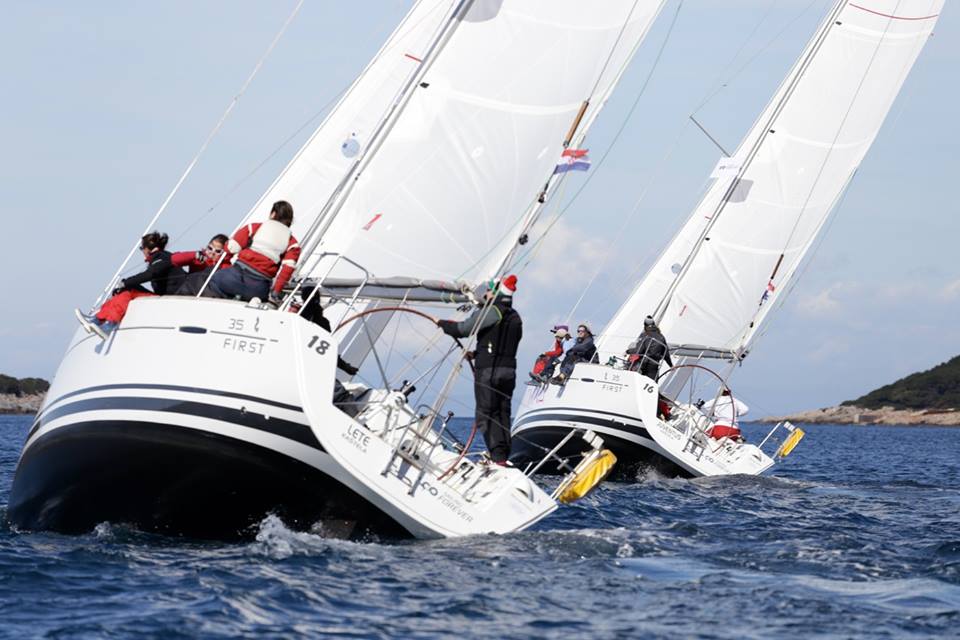
What was the motivation behind creating the PMS Women’s Sailing Regatta?
The motivation behind the regatta was quite simply to create the only, exclusively women’s sailing race. It was in an effort to promote the sport but especially women in sailing, and International Women’s Day gave great timing and motivation to make it happen. This women’s sailing regatta is also unique because it is a sporting event on the island which is totally out of season.
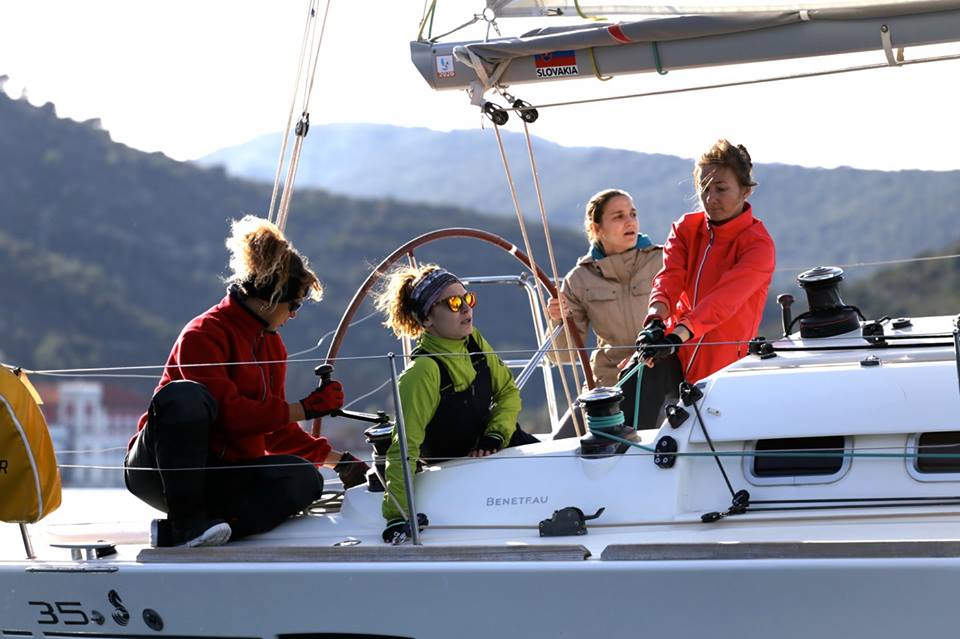
How has it developed over the past 5 years?
In the first year, we had only 3 crews, all from Croatia.
2016: 6 crews; 1 crew from Austria, 2 crews from Slovakia, 3 crews from Croatia
2017: we had 11 crews in total; 2 crews from Austria, 2 crews from Slovakia, 2 crews from Montenegro, 1 crew from Hungary, 1 crew from Italy, 1 crew from the Czech Republic, 2 crews from Croatia.
2018: 7 crews; 1 crew from Austria, 1 crew from Slovakia, 1 crew from Montenegro, 1 crew from Hungary, 3 crews from Croatia
2019: This year we had 9 crews; 1 crew from Austria, 1 crew from Montenegro, 2 crews from Hungary, 1 crew from Italy, 2 crews from Croatia and two mixed International crews: WOB1 - Italy, Switzerland, Czech Republic, New Zealand, Croatia, Serbia and WOB2: Ukraine, Italy, Germany, Slovenia, Slovakia and Croatia
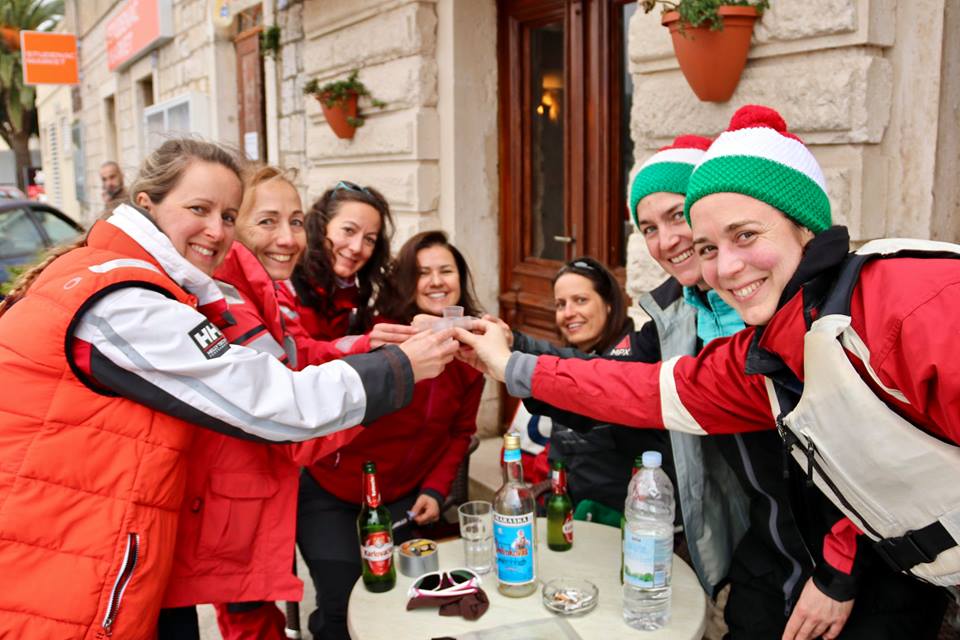
Tell us a little about the history of sailing in Croatia, and women in sailing?
The first sailing club in Croatia was founded in 1876. The oldest regatta in Croatia is the Mrdujska Regatta, which was established in 1927. The organiser of this women’s sailing regatta (PMS Žena) is YC HOST from island Vis. The club's first regatta was the Adriatic Race (13th incarnation this year) which is one of the most challenging regattas, it is around 250 miles from Vis – Dubrovnik – Palagruža – Vis.
So, while sailing in Croatia and regattas have been here for the better part of a century; the PMS Žena women's sailing regatta promotes women in sailing because there still aren't enough women in sailing (Croatia and worldwide), but things are slowly changing. In the past, women were not welcome on a boat, but today it is normal for women to cross the ocean and circumnavigate the globe. Women are present in sailing, but we still need to do more to promote this sport and encourage more women.
Participating in the PMS Žena women's sailing regatta, are women of all ages but we are especially pleased to see new, young crews appearing every year.
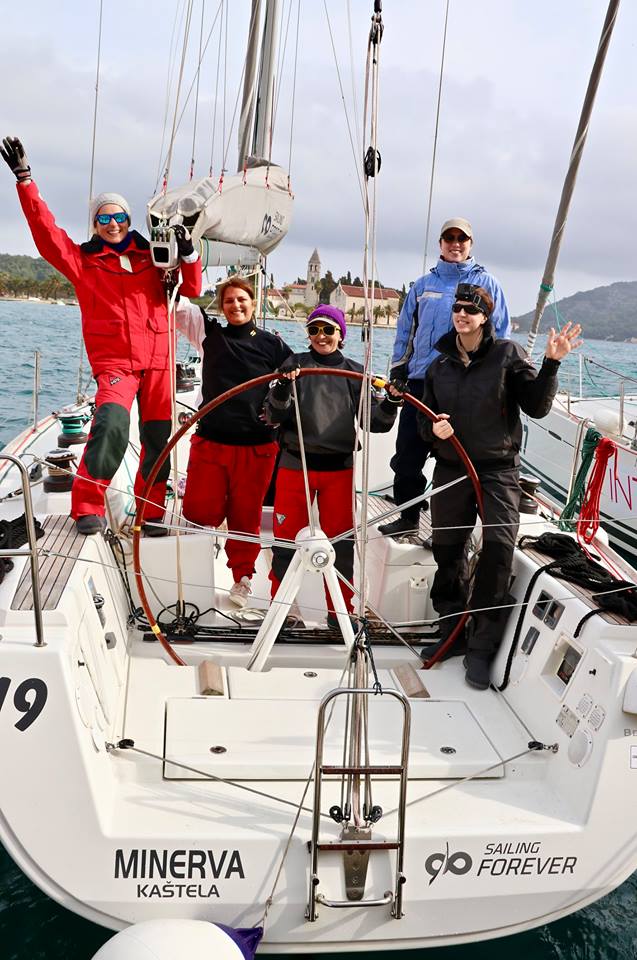
What was the highlight of the PMS Žena Women's Sailing Regatta 2019?
The highlight this year was the atmosphere of the competition, but also the mutual support between the crews and the feeling of common enjoyment in this unique women's sailing event. Maybe it was like this because for the first time we had international crews.
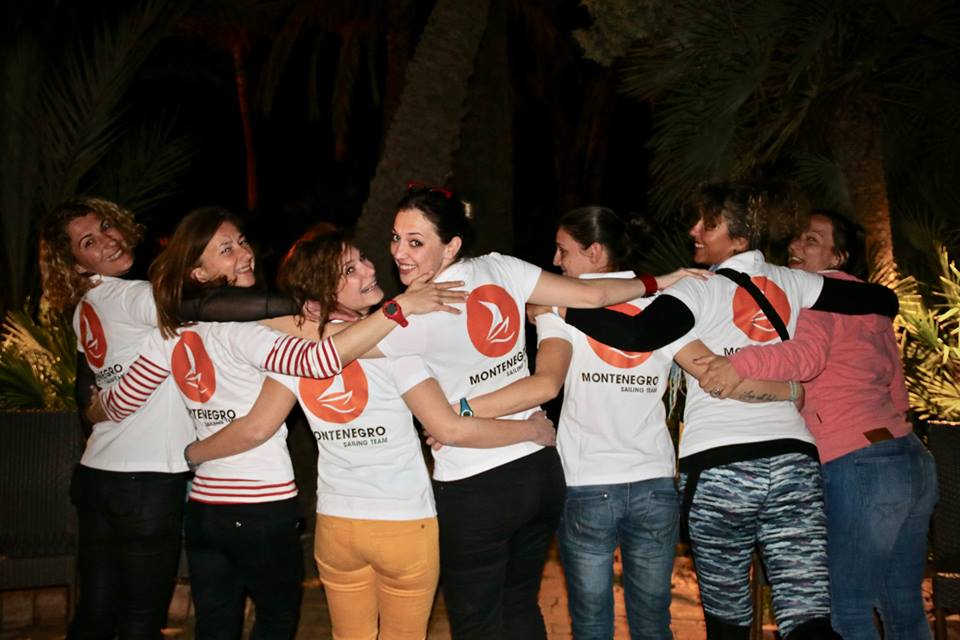
Have you received support for the PMS Žena Women's Sailing Regatta?
Without the generosity of all of the past sponsors and support from the local community, it would be nearly impossible to secure the means and support of this important sports competition. A huge thanks goes out to all of the former patrons who have enabled development of this event, whether they helped in the form of food and drinks, providing accommodation, or being involved with the logistics and organisation of the event itself.
Our main sponsor is INTIMINA, but there are a lot of other sponsors like private firms, and of course, the support of the local community and people from the clubs who work voluntarily for 4 days.
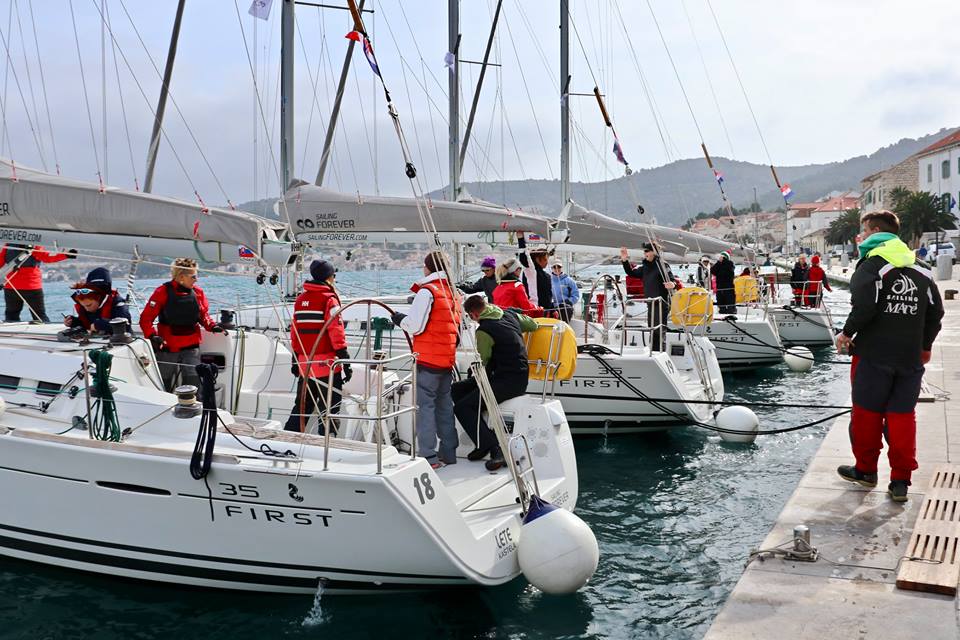
What are your hopes for the PMS Žena Women's Sailing Regatta in 2020?
We received a lot of praise for the event this year; the organisation, atmosphere, food, hospitality. So, we hope to better the women’s regatta next year. Thanks to all who were involved and see you at the PMS Žena Women's Sailing Regatta in 2020
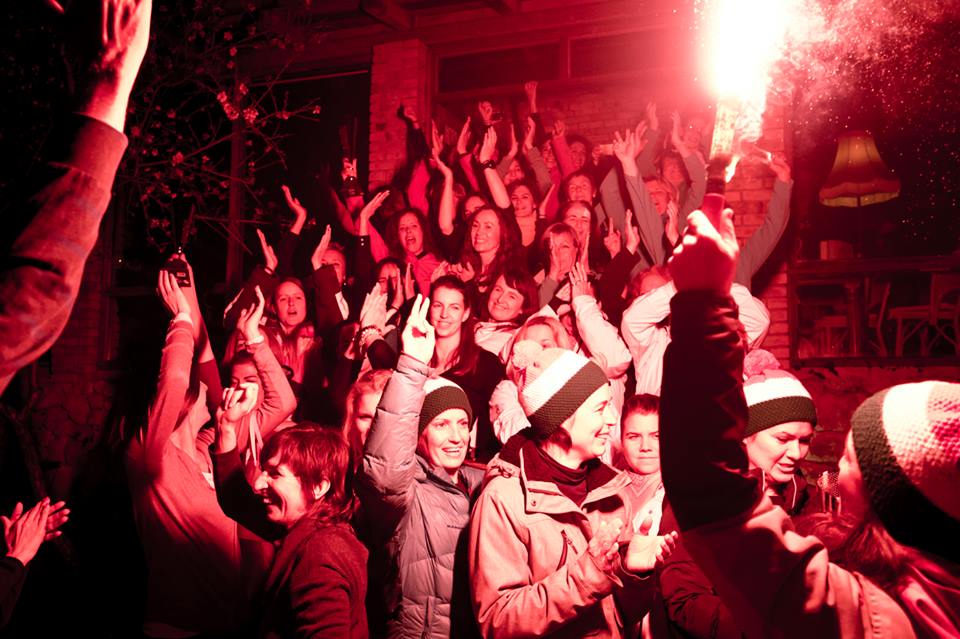
A few words from the only Kiwi in this International Women's Sailing Regatta
Sammie Williams, grew up sailing in NZ, she was introduced to the sport by friends and has had the bug ever since. Sammie is an accomplished sailmaker and now lives in Montenegro skippering a Hanse, she tells us her impressions as a participant of the PMS Žena women’s sailing regatta.
"I haven’t done many regattas before, more day sailing events, tall ship racing, two-handed, off-shore, inshore… My first regatta was the Hanse Cup Regatta in Croatia last year. I was the only kiwi in this international mix of women; this was the first female regatta I have ever attended, and it was amazing! I couldn’t believe how many female sailors there were, and, all in one place! The organisation was incredible and the food and housing provided were superb. I was in WOB1 (Welcome on Board International) which was Claudia’s idea to put a boat together of all different nationalities; she managed to bring together 12 women from 11 different countries! No one had met prior to the regatta, so we weren’t sure how we would go but my team placed 3rd overall, and the other team WOB2 placed 5th – so, we didn’t do too bad at all!
I’ve never heard of a women’s sailing regatta before and honestly, never really thought there were enough women to pull it off, but the weekend has definitely proved me wrong! As well as the atmosphere and the racing, the entire organisation was phenomenal and very affordable – around 35 euro per person, which included all accommodation, lunch and dinners. The whole island pulled together and helped to create this event which was really fantastic to see. I will definitely be back.”
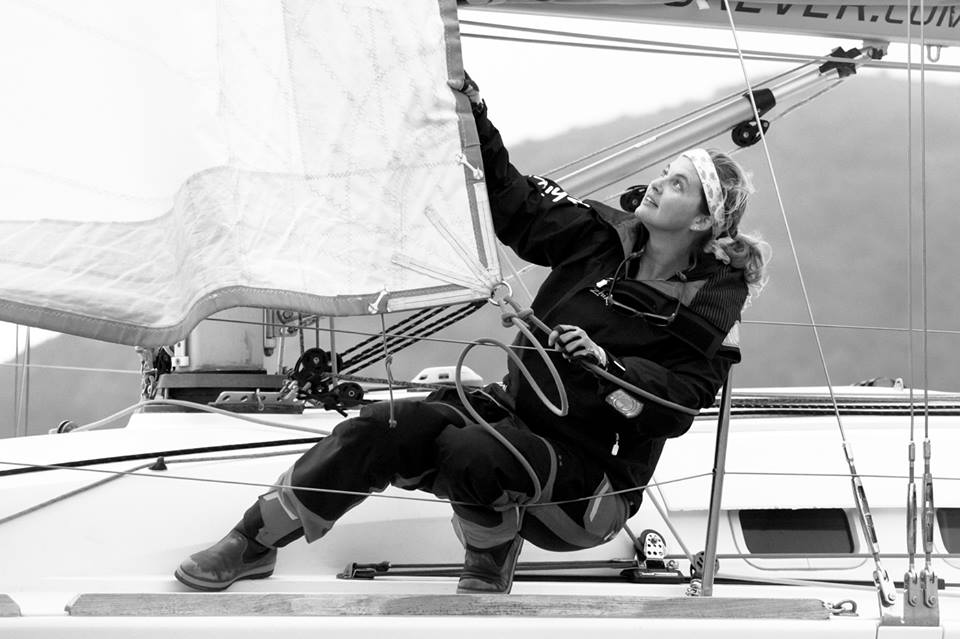
Photo credit: Mate Acalinović, Sammie Williams rocking it on the bow!
2019 Results for the PMS Žena Women's Sailing Regatta

All photos courtesy of Ante Acalinović, Alenka Alujević, Adriatic Race Official, and Welcome on Board International Sailing Team.
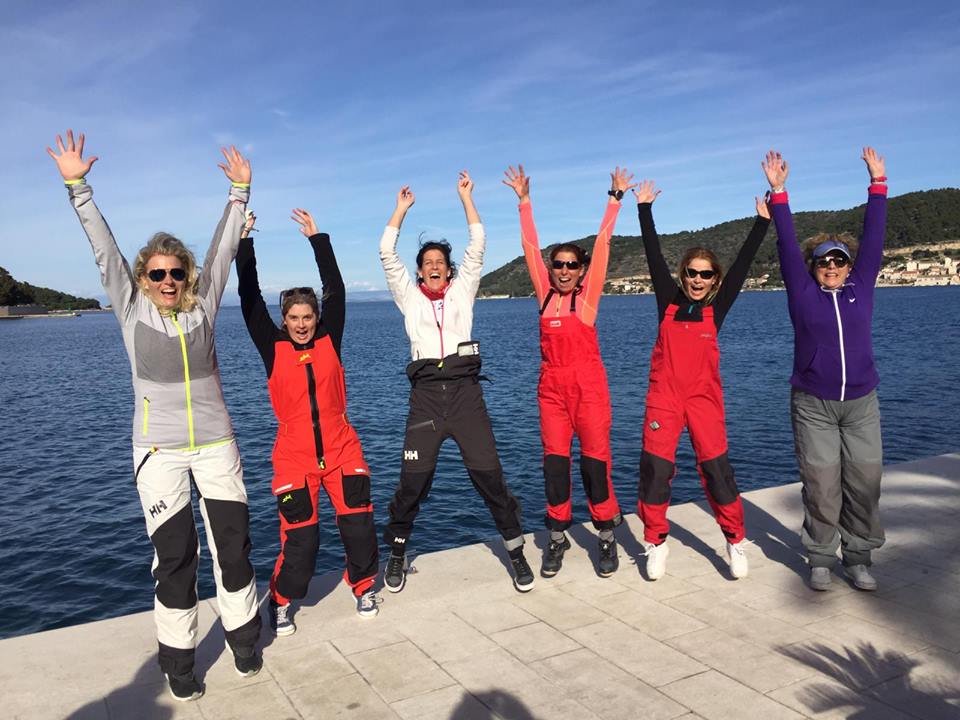
If you would like to see more about Sailing in Croatia, you can visit our Facebook page, or find more news on Total Croatia Sailing. For more on Sports or News in Croatia, visit Total Croatia News.
Hajduk Player's 'Cojones' Celebration Grabs Attention of International Media
March 15, 2019 - You might recall Hajduk making international headlines last month as their iconic badge became the center of Liam Gallagher’s clothing line Pretty Green. The Split club has grabbed media attention once again, but this time, for a goal celebration by one of their youngsters.
Namely, Hajduk U19 player Tino Blaž Lauš put Hajduk up 3:1 against Hrvatski Dragovoljac in the Junior Croatian First League over the weekend. Lauš scored in the 57th minute to win the game, and after the ball hit the Dragovoljac net, he chose to celebrate in the rather controversial style of Cristiano Ronaldo and Atletico Madrid coach Diego Simeone.
The Hajduk player’s celebration, which is now coined the ‘Cojones Celebration’, was first done by Simeone after Atletico scored the second goal in the first leg of the Champions League round of 16 against Juventus. You can see the act below.
No one:
— Nooruddean (@BeardedGenius) February 20, 2019
Diego Simeone: pic.twitter.com/ao1EuDTpoO
“I did it as a player at Lazio and I did it again to show our fans that we have cojones,” Simeone said after the match.
Cristiano Ronaldo then mimicked the famous move in the second leg after scoring a hat trick to advance Juventus to the quarterfinals.
#Ronaldo come Simeone #JuveAtelti pic.twitter.com/hh3veIMKuk
— Tutti Convocati (@tutticonvocati) March 12, 2019
While Simeone was only fined for his celebration, UEFA announced they would open an inquiry into the Ronaldo gesture, which could see the famous footballer receive a fine, and even a disqualification for a game.
Who did the celebration better..
— Night_kyng (@Public_Enemyy) March 12, 2019
Simeone or ronaldo? ???#JuveAtleti pic.twitter.com/MDOc5gBQUA
In Croatia, however, referee Ivan Vučković was not so forgiving. After Lauš imitated Simeone and Ronaldo, he received a red.
Hajduk Split youth star sent off for Diego Simeone celebration https://t.co/tLLGxodj6K pic.twitter.com/CYF7wsHWV0
— The Sun Football ⚽ (@TheSunFootball) March 15, 2019
International media including Bleacher Report, The Sun, Daily Mail, and Sport Bible have all picked up the story, and many users on Reddit wonder if the Croatian call was fair at all.
“Am I the only one who doesn't think anyone should get carded for this?” said one user. “Let the boy play” said another. “Refs are just football mods. Ignore half of the rule-breaking but if you dare make fun of them they'll use all their spergy rage upon you,” was also among the comments.
And then there are those who believe it was the only fair decision.
“Deserved. Have some manners on the pitch” and “Don’t do everything you see on TV kids” are just a few.
Should Lauš have been sent off? We’ll let you decide.
To read more about sport in Croatia, follow TCN’s dedicated page.
Gradsko Oko: Split Launches Mobile App for Utility, Traffic and Infrastructure Issues
“The new Gradsko Oko (City Eye) mobile application will become the main channel that citizens will use for reporting utility, traffic and infrastructure problems and within a week, receive feedback on the status of resolving their cases,” announced the City of Split Administration on Friday, March 15, 2019.
Citizens will, at any time, be able to see the status of their application as well as the percentage of resolved claims. The project will last two years and will be run by the Rijeka company RI-ING NET, after which it will be taken over by the City of Split. The City paid 120,000 kuna for two years of use.
“Last year we recruited utility, transport and agricultural workers who are now getting their tools,” said Mayor Andro Krstulović Opara, pointing out that this application is taking a step forward in advanced technologies that make it easier to solve city problems.
According to the head of the Service for International and EU Funds Radojka Tomašević, Gradsko Oko was commissioned for the needs of Split's communal department. Thus, the City of Split is one of ten in Croatia which, by using this application, enables two-way communication and access to various participants and citizens.
To report a problem, you will need to download the application to your mobile phone, sign in and then get to work. You can report a problem with a photo or by submitting a comment, give a location, and leave a valid address, email or SMS where you can receive an answer. You will also be able to track the status of your application.
According to Ivica Grubišić, the mayor's municipal advisor, citizens who report a problem will receive a response within seven days of the request. However, this does not mean that the problem will be solved within that deadline, but that the jurisdiction of the departments responsible for resolving the issue will be determined if it is not the City of Split. Two utility commissions will be responsible for the applications, and each applicant will be notified of the status of their inquiries via messages.
It is, therefore, necessary to register every citizen as there are no anonymous applications. This was confirmed by the director of the company RI-ING NET, Marko Andrić, who presented the Gradsko Oko application as a segment of the larger Pazigrad project. This is a system that enables the inclusion of a wide range of participants in the simple creation of a record of communal problems. The system has been in use since 2014, and 60 local governments use one of their solutions.
“This application is already used in ten cities in Croatia, mostly in Istria. In Dalmatia, only the municipality of Marina uses the service. The application proved to be a good solution, and the City of Split has chosen one of the shorter deadlines for responding to citizens,” says Marko Andrić for Splitski Dnevnik.
This application should also be part of the larger city project Smart City Suite, where you will be able to follow public transport, where to rent the nearest bicycle, but also find the free business spaces in the city. It should also represent an upgrade to the existing city parking application and include a range of new services for citizens and tourists, like Smart Bus, Municipal Applications, City Events, Information and News, Business Premises and Smart Bike.
Citizens will be offered an opportunity to use various services in the City of Split, and all city companies and institutions through a unique smart city card.
"We hope to continue with this application after two years, but our plans are great because we want to create one platform where all these applications that are developing in parallel will be networked in one place," added Radojka Tomašević.
To read more about lifestyle in Croatia, follow TCN's dedicated page.
How to Start a Digital Career in Split? Programmers and Experts Weigh In
University will not get you a job; you have to work hard to gain knowledge before employment. This was addressed by representatives of Locastic, Ericsson Nikola Tesla, Typeqast and Netmedia at a panel discussion on 'How to Start a Digital Career', held on Thursday night at the new PICS Center at Split University's Faculty of Electrical Engineering, Mechanical Engineering, and Naval Architecture (FESB), reports Dalmatinski Portal on March 15, 2019.
“Programmers in Split can choose where they want to work; it is a good life decision to be a programmer today. The renaissance is happening because every branch of the industry is based on IT, and some of these solutions have to be made,” said Marko Barić, Director and Development Manager at the Split branch of the Dutch company Typeqast.
“You need to learn the job before you get hired, knowledge is available and relatively inexpensive over the internet. Small firms cannot hire and educate, and, unfortunately, faculties unleash you with a low level of knowledge. During my studies, I bought 40 books through Amazon, nobody made me do it, and today I read two a month because if you do not follow the development, you are nowhere in two years,” added Barić,
Marko Maljković of Locastic shares Barić's opinion.
“Students will not learn the basics, they can learn from tutorials, and in our company, we can face a concrete problem whose solution can be helped by our experience. After 14 years of design, I continue to explore and learn new applications today,” said the founder of the Split company.
Grades from the faculties are not the most important, according to Goran Škugor from Ericsson Nikola Tesla, which employs 550 people. Project manager of ICT County Damir Brčić moderated the debate and asked Škugor how even the best FESB students can’t get a job.
“The question is what the best student is? We constantly need employees, and we are constantly in contact with students. In a job interview, grades from University come in 22nd place. We are more interested in the concrete things and whether you show interest in the engineering things you worked on at University. It's nice to have an average of 4.8, but we'd rather give a chance to the one who had 2.8 but did something specific. In that sense, I would advise students to pursue seminar work, it is better to choose something more difficult to learn than only to do something as soon as possible,” said Škugor.
He revealed that they also do personality tests before employment, to make sure that the personalities of the workers fit into the team. Other panelists agreed.
“Programming is a lot of teamwork, technical knowledge can be learned, but personality cannot. We are also looking for social skills, not just technical ones,” said Barić.
But how does a student know what they want to do in life?
"It's good to know what you want. I wanted to work at the Lego factory, and this desire led me to design,” revealed Maljković, adding:
“Assemble a team here at PICS, start working and learning from errors, and your work will determine the direction you will go.”
“Put your shoes on and run,” said Škugor, and Barić said that it is all a matter of work:
“For years, from Monday to Friday, you could train tennis in the morning, in the afternoon and the evening, and you would become a tennis player, perhaps not the best but you could play. This is also the case with programming.”
The co-owner of Netmedia, Ivan Strigo, said that much has changed.
“10-15 years ago people came to us who knew exactly what they wanted to do, and now they are knocking on our door and saying: 'I would like to be a programmer.' We give them two books and they do not come back.”
The motivation to work in companies and the IT sector should not be missed. Barić pointed out:
“Programming is not coding, it's changing the world. We solve problems.”
"We are architects of society, it is powerful," Strigo concluded.
PICS is the new pre-incubator and coworking center at the University of Split, implemented within the ICT County project. It is intended for students, young innovators and all those interested in IT work, whose projects, with the help of a network of educators and mentors, will have the opportunity to enter the world market.
To read more about lifestyle in Croatia, follow TCN’s dedicated page.
50 Shades of Green: World's Healthiest Foods Packed into 5-course Split Lunch
March 15, 2019 - A list of the 100 healthiest foods have been known for some time and have been confirmed by experts around the world. While you can find these ingredients as a part of everyday nutrition and in many international catering establishments, you cannot, however, often see them on the menus of Split or Dalmatian restaurants, even though tourists say that authenticity is one of the most critical items in gastronomy.
To encourage local restaurants to use foods that are not only traditional but also healthy, famous Split nutritionist Olja Martinić organized an educational lunch called "50 Shades of Green". The name was carefully selected because the owners of the Split restaurant Zora Bila, Sandra and Dane, managed to craft a menu of five courses that included as many as 51 items from the world’s healthiest list.
The lunch, as expected, was very successful, and even paired each course with top-quality Dalmatian wines from Winebox, whose bases are also foods from this interesting list.
“Nutrition has never been as involved in modern gastronomy as it is today. Over the past ten years, the need for changing eating habits throughout the modern world has been intensified, and a lot of scientific research has contributed to this. Among the most deserving of proving the connection between human health and diet are two world-renowned scientists. The renowned Georg Mateljan is the author of the concept of the 100 healthiest foods in the world, and Mrs. Michelle Obama has also used his great knowledge in her project to improve eating habits. A distinguished biologist from Sorbonne (Paris), Prof. Dr. Duško Erlich, gave an incredible contribution to the study of the digestive system and its role in the usability of nutrients. Sharing important scientific facts with caterers who expect a productive season and thus show respect for guests was the basis for setting up the concept of this themed lunch. It is easy to pass on the knowledge along with the great and selfless support of the media that have been the true promoters of the Mediterranean diet all these years,” said Martinić.
At the top of this list is spinach, beets, asparagus, Swiss chard, tomatoes, broccoli, carrots, and cucumbers, and from the fruit, you can find raspberries, strawberries, melon, oranges, watermelon, bananas and kiwis. From dairy products, there are eggs and cow's milk from domestic production, and from grains, you'll find oats and barley. Parsley and basil, as well as black pepper, are at the top of spices and herbs, while beef and turkey from extensive farming are included in the meat.
The goal of this lunch was to promote the foods of the Mediterranean and brand Split on the increasingly demanding world gastronomic scene, said the duo behind Zora Bila.
Guests enjoyed tuna sashimi, soy sauce, young onions, ginger, chili paprika, avocado, and wasabi mayonnaise paired with an Ivan Dolac rose. The second course was orzoto with a scampi bisque and roasted shrimp, garlic foam, and edible gold paired with the Zlatarica Pilač from Vrgorac. Course number three was sous vide egg with asparagus, pancetta, and truffle, paired with the Debit Sladić from Plastovo. Course four was steak with a selection of vegetables and a sauce of yellow tomatoes, all cooked as George Mateljan recommended in his book, paired with the Sagul 2016 Plavac Mali from Winery Violić in Pelješac. And for dessert? Panna cotta with lemon, almond, orange, raspberries and a special liquor from WineBox.
To read more about lifestyle in Croatia, follow TCN’s dedicated page.
Sources: Skitopisi, Splitski Dnevnik


